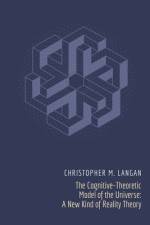av Christopher Michael Langan
289,-
Paperback version of the 2002 paper published in the journal Progress in Information, Complexity, and Design (PCID).ABSTRACT: Inasmuch as science is observational or perceptual in nature, the goal of providing a scientific model and mechanism for the evolution of complex systems ultimately requires a supporting theory of reality of which perception itself is the model (or theory-to-universe mapping). Where information is the abstract currency of perception, such a theory must incorporate the theory of information while extending the information concept to incorporate reflexive self-processing in order to achieve an intrinsic (self-contained) description of reality. This extension is associated with a limiting formulation of model theory identifying mental and physical reality, resulting in a reflexively self-generating, self-modeling theory of reality identical to its universe on the syntactic level. By the nature of its derivation, this theory, the Cognitive Theoretic Model of the Universe or CTMU, can be regarded as a supertautological reality-theoretic extension of logic. Uniting the theory of reality with an advanced form of computational language theory, the CTMU describes reality as a Self Configuring Self-Processing Language or SCSPL, a reflexive intrinsic language characterized not only by self-reference and recursive self-definition, but full self-configuration and self-execution (reflexive read-write functionality). SCSPL reality embodies a dual-aspect monism consisting of infocognition, self-transducing information residing in self-recognizing SCSPL elements called syntactic operators. The CTMU identifies itself with the structure of these operators and thus with the distributive syntax of its self-modeling SCSPL universe, including the reflexive grammar by which the universe refines itself from unbound telesis or UBT, a primordial realm of infocognitive potential free of informational constraint. Under the guidance of a limiting (intrinsic) form of anthropic principle called the Telic Principle, SCSPL evolves by telic recursion, jointly configuring syntax and state while maximizing a generalized selfselection parameter and adjusting on the fly to freely-changing internal conditions. SCSPL relates space, time and object by means of conspansive duality and conspansion, an SCSPL-grammatical process featuring an alternation between dual phases of existence associated with design and actualization and related to the familiar wave-particle duality of quantum mechanics. By distributing the design phase of reality over the actualization phase, conspansive spacetime also provides a distributed mechanism for Intelligent Design, adjoining to the restrictive principle of natural selection a basic means of generating information and complexity. Addressing physical evolution on not only the biological but cosmic level, the CTMU addresses the most evident deficiencies and paradoxes associated with conventional discrete and continuum models of reality, including temporal directionality and accelerating cosmic expansion, while preserving virtually all of the major benefits of current scientific and mathematical paradigms.



